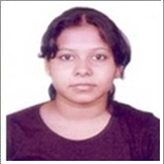List of publications
A. During Ph.D
- Chakraborty S., Nair G.B., and Shinoda S. Pathogenic Vibrios in the natural aquatic environment. Rev. Environ. Health 1997 Apr-Jun; 12(2): 63-80. Review
- Hoshino K., Yamasaki S., Mukhopadhyay A.K., Chakraborty S., Basu A., Bhattacharya S.K., Nair G.B., Shimada T., Takeda Y. Development and evaluation of a multiplex PCR assay for rapid detection of toxigenic Vibrio cholerae O1 and O139. FEMS Immunol. Med. Microbiol. 1998 Mar; 20(3): 201-207
- Bhattacharya M.K., Dutta D., Deb A., Garg P., Chakraborty S., Mukhopadhyay A.K., Bhattacharya S.K. Acute secretory traveler’s diarrhoea caused by Vibrio cholerae which does not belong to the O1 or O139 serogroup. Nat. Med. J. India, 1998 11 (5), 248.
- Guhathakurta B., Sasmal D., Pal S., Chakraborty S., Nair G.B., Datta, A. Comparative analysis of cytotoxin, hemolysin, hemagglutinin and exocellular enzymes among clinical and environmental isolates of Vibrio cholerae O139 and non-O1 and, non-O139. FEMS Microbiol Lett. 1999 Oct 15; 179 (2): 401-407
- Chakraborty S., Khanam J., Takeda Y., Nair G.B. Application of PCR for detection of toxigenic Vibrio cholerae O1 in water samples during on outbreak of cholera. Trans. R. Soc. Trop. Med. Hyg. 1999 Sep-Oct; 93 (5): 527-528
- Basu I., Mukhopadhyay A.K., Garg P., Chakraborty S., Ramamurthy T., Yamasaki S., Takeda Y., Nair G.B. Diversity in the arrangement of the CTX prophages in classical strains of Vibrio cholerae O1. FEMS Microbiol Lett. 2000 Jan 1; 182 (1): 35-40
- Basu A., Garg P., Datta S., Chakraborty S., Bhattacharya T., Khan A., Ramamurthy T., Bhattacharya S.K., Yamasaki S., Takeda Y., Nair G.B. Vibrio cholerae O139 in Calcutta, 1992-1998: incidence, antibiograms, and genotypes. Emerg. Infect. Dis. 2000 Mar-Apr; 6(2): 139-147
- Ramamurthy T., Chakraborty S., Nair G.B., Bhattacharya S.K. Health impairments arising from drinking water resources contaminated with Vibrio cholerae. Schriftenr. Ver. Wasser Boden. Lufthyg. 2000; 105: 29-34
- Chakraborty S., Mukhopadhyay A.K., Bhadra R.K., Ghosh A.N., Mitra R., Shimada T., Yamasaki S., Faruque S.M., Takeda Y., Colwell R.R., Nair G.B. Virulence genes in the environmental strains of Vibrio cholerae. Appl. Environ Microbiol. 2000 Sep; 66(9): 4022-4028
- Garg P., Chakraborty S., Basu I., Datta S., Rajendran K., Bhattacharya T., Yamasaki S., Bhattacharya S.K., Takeda Y., Nair G.B., Ramamurthy T. Expanding multiple antibiotic resistance among clinical strains of Vibrio cholerae isolated from 1992-1997 in Calcutta, India. Epidemiol. Infect. 2000 Jun; 124(3): 393-399.
- Chowdhury N.R., Chakraborty, S., Eampokalap, B., Chaicumpa W., Chongsa-Nguan M., Moolasart P., Mitra R., Ramamurthy T., Bhattacharya S.K., Nishibuchi M., Takeda, Y., Nair, G.B. Clonal dissemination of Vibrio parahaemolyticus displaying similar DNA fingerprint but belonging to two different serovars (O3:K6 and O4:K68) in Thailand and India. Epidemiol. Infect. 2000 Aug; 125 (1): 17-25.
- Chowdhury N.R., Chakraborty S., Ramamurthy T., Nishibuchi M., Yamasaki S., Takeda Y., Nair G.B. Molecular evidence of clonal Vibrio parahaemolyticus pandemic strains. Emerg. Infect. Dis. 2000 Nov-Dec; 6 (6): 631-636.
- Mukhopadhyay A.K., Chakraborty S., Takeda Y., Nair G.B., Berg B.E. Characterization of VPI pathogenicity island and CTXphi prophage in environmental strains of Vibrio cholerae. J. Bacteriol. 2001 Aug; 183(16): 4737-4746.
- Chakraborty S., Garg P., Ramamurthy R., Thungapathra M., Gautam J.K., Kumar C., Maiti S., Yamasaki S., Shimada T., Takeda Y., Ghosh A., Nair G.B. Comparison of antibiogram, virulence genes, ribotypes and DNA fingerprints of Vibrio cholerae of matching serogroups isolated from hospitalized diarrhoea cases and from the environment during 1997-1998 in Calcutta, India. J. Med. Microbiol. 2001 Oct; 50 (10): 879-888
- Chhotray G.P., Pal B.B., Khuntia H.K., Chowdhury N.R., Chakraborty S., Yamasaki S., Ramamurthy T., Takeda Y., Bhattacharya S.K., Nair G.B. Incidence and molecular analysis of Vibrio cholerae associated with cholera outbreak subsequent to the super cyclone in Orissa, India. Epidemiol Infect. 2002 Apr; 128 (2): 131-138
B. During Post-Doc
- Chakraborty S., Senyuk V., Nucifora G. Genetic lesions and perturbation of chromatin architecture: a road to cell transformation. J. Cell Biochem. 2001; 82 (2): 310-325. Review
- Chakraborty S., Senyuk V., Sitailo S., Chi Y., Nucifora G. Interaction of EVI1 with c-AMP-responsive element-binding protein-binding protein (CBP) and p300/CBP-associated factor (P/CAF) results in reversible acetylation of EVI1 and in co-localization in nuclear speckles. J. Biol. Chem. 2001 Nov 30; 276(48): 44936-44943.
- Senyuk V., Chakraborty S., Mikhail F.M., Zhao R., Chi Y., Nucifora G. The leukemia–associated transcription repressor AML1/MDS1/EVI1 requires CtBP to induce abnormal growth and differentiation of murine hematopoietic cells. Oncogene 2002 May 9; 21 (20): 3232-3240.
- Chakraborty S., Sinha KK., Senyuk V., Nucifora G. SUV39H1 interacts with AML1 and abrogates AML1 transactivity. AML1 is methylated in vivo. Oncogene 2003; 22: 5229-5237
- Senyuk V., Sinha KK., Chakraborty S., Buonamici S., Nucifora G. P/CAF and GCN5 acetylate the AML1/MDS1/EVI1 fusion oncoprotein. Biochem. Biophys. Res. Commun. 2003 Aug 8; 307 (4): 980-986
- Buonamici S., Chakraborty S., Senyuk V., Nucifora G. The role of EVI1 in normal and leukemic cells. Blood Cells, Molecules, & Diseases. 2003; 31(2):206-212
- Chakraborty S., Buonamici S., Senyuk V., Nucifora G. Ecotropic Viral Integration 1 Site (EVI1) and Myelodysplastic Syndrome 1 (MDS1)-EVI1. Atlas Genet Cytogenet Oncol Haematol. May 2003.
URL: http://www.infobiogen.fr/services/chromcancer/Genes/EVI103q26ID19.html
- Chi Y., Senyuk V., Chakraborty S, Wang X., Nucifora G. EVI1 promotes cell proliferation by interacting with BRG1 and blocking the repression of BRG1 on E2F activity. J. Biol. Chem. 2003 Dec; 278(50): 49806-49811.
- Laricchia-Robbio L, Fazzina R, Li D, Rinaldi CR, Sinha KK, Chakraborty S, Nucifora G. Point mutations in two Evi1 Zn fingers abolish EVI1-GATA1 interaction and allow erythroid differentiation of murine bone marrow cells. Mol. Cell Biol. 2006 Oct; 26(20):7658-66.
C. As an independent faculty
- Kuila N, Sahoo DP, Kumari M, Biswas S, Patnaik RS, Pattnayak NC, Biswas G, Chakraborty S. EVI1, BAALC and AME: prevalence of the secondary mutations in chronic and accelerated phases of chronic myeloid leukemia patients from eastern India. Leuk Res. 2009 Apr;33(4):594-6.
- Kuila N, Dash N, Sahoo DP, Pattnayak NC, Biswas G, Chakraborty S. Presence of a new BCR-ABL kinase domain mutation, C330G in an imatinib naive patient with chronic myeloid leukemia: very low prevalence of BCR-ABL kinase domain mutations in patients with chronic myeloid leukemia from eastern India. Leuk Lymphoma. 2009 Apr; 50(4):663-6.
- Pradhan AK, Kuila N, Singh S, Chakraborty S. EVI1 up-regulates the stress responsive gene SIRT1 which triggers deacetylation and degradation of EVI1. Biochim Biophys Acta-Gene Regulatory Mechanism 2011 Apr-Jun;1809 (4-6):269-75.
- Pradhan AK, Mohapatra AD, Nayak KB, Chakraborty S. Acetylation of the Proto-Oncogene EVI1 Abrogates Bcl-xL Promoter Binding and Induces Apoptosis. PLOS ONE, 2011; 6(9):e25370.
- Agatheeswaran S, Singh S, Biswas S, Biswas G, Chandra Pattnayak N, Chakraborty S. BCR-ABL mediated repression of miR-223 results in the activation of MEF2C and PTBP2 in chronic myeloid leukemia. Leukemia 2013 Jul;27(7):1578-80.
- Nayak KB, Kuila N, Mohapatra AD, Panda AK, Chakraborty S. EVI1 targets ∆Np63 and upregulates the cyclin dependent kinase inhibitor p21 independent of p53 to delay cell cycle progression and cell proliferation in colon cancer cells. Int J Biochem Cell Biol. 2013 May 9;45(8):1568-1576
- Singh S, Pradhan AK, Chakraborty S. SUMO1 negatively regulates the transcriptional activity of EVI1 and significantly increases its co-localization with EVI1 after treatment with arsenic trioxide. Biochim Biophys Acta – Molecular Cell Research 2013 Jun 13;1833(10):2357-2368.
- Pradhan AK and Chakraborty S. EVI1 targets the cell adhesion molecule PECAM1 and up regulates its expression in chronic myeloid leukemia. Leuk Lymphoma 2014 Apr; 55(4):954-6.
- Pradhan AK, Halder A, Chakraborty S. Physical and functional interaction of the proto-oncogene EVI1 and tumor suppressor gene HIC1 deregulates Bcl-xL mediated block in apoptosis. Int J Biochem Cell Biol. 2014 Jun 5; 53C:320-328.
- Agatheeswaran S, Chakraborty S. Response to “JAK2/STAT5 inhibition by nilotinib with ruxolitinib contributes to the elimination of CML CD34+ cells in vitro and in vivo”. [E-Letter] Blood (http://www.bloodjournal.org/content/124/9/1492.e-letters). 5 September 2014
- Mandal M, Tripathy R, Panda AK, Pattanaik SS, Dakua S, Pradhan AK, Chakraborty S, Ravindran B, Das BK. Vitamin D levels in Indian systemic lupus erythematosus patients: association with disease activity index and interferon alpha. Arthritis Res Ther. 2014 Feb 10;16(1):R49.
- Rajashree SN, Kuila N, Biswas S, Pattnayak NC, Biswas G, Chakraborty S. Dual transcripts of BCR–ABL and different polymorphisms in Chronic Myeloid Leukemia patients from Odisha, India. Indian Journal of Medical Research. 2016 May;143(Supplement):S136-S141.
- Agatheeswaran S and Chakraborty S. MEF2C and CEBPA: possible coregulators in Chronic Myeloid Leukemia disease progression. Int J Biochem Cell Biol. 2016 Aug;77(Pt A):16570.
- Agatheeswaran S, Pattnayak NC, and Chakraborty S. Identification and functional characterization of the miRNA gene regulatory network in chronic myeloid leukemia lineage negative cells. Sci Rep. 2016 Sep 2;6:32493
- Kuila N, Nayak KB, Halder A, Agatheeswaran S, Biswas G, Biswas S, Pattnayak NC and Chakraborty S. Ecotropic viral integration site I regulate alpha-1, 6 fucosyl transferase expression and blocks erythropoiesis in chronic myeloid leukemia. Leuk. Lymphoma. 2016. Dec 14:1-7.
- Roobrouck VD, Wolfs E, Delforge M, Broekaert D, Chakraborty S, Sels K, Vanwelden T, Holvoet B, Lhoest L, Khurana S, Pandey S, Hoornaert C, Ponsaerts P, Struys T, Boeckx N, Vandenberghe P, Deroose CM, Verfaillie CM. Clinical-grade Multipotent Adult Progenitor Cells improve the hematopoietic function in myelodysplasia. Cytotherapy. 2017 Jun;19(6):744-755
- Halder A, Nayak KB and Chakraborty S. EVI1 transcriptionally targets Talin1 (TLN1) and upregulates its expression in Chronic Myeloid Leukemia. Leuk Lymphoma. 2017 Dec 7:1-3.
- Nayak KB, Sajitha I. S., T.R. Santhosh Kumar and Chakraborty S. Ecotropic viral integration site 1 promotes metastasis independent of epithelial mesenchymal transition in colon cancer cells. Cell Death Dis. 2018 Jan 16;9(2):18.
- Nandagopalan SR, Agatheeswaran S, Vadlamudi Y, Biswas S, Biswas G, Pattnayak NC, Chakraborty S. PTBP2 exon 10 inclusion is associated with the progression of CML and it is BCR-ABL1 dependent. Int J Biochem Cell Biol. 2019 Feb 3;109:69-75.
- Pradeepa, Suresh V, Singh VK, Nayak KB, Senapati SB, Chakraborty S. EVI1 Promotes Metastasis by Downregulating TIMP2 in Metastatic Colon and Breast Cancer Cells. Int J Biochem Cell Biol. 2022 Jan;142:106118.
- Pradeepa, Suresh V, Senapati SB, Chakraborty S. AKT inhibition sensitizes EVI1 expressing colon cancer cells to irinotecan therapy by regulating the Akt/mTOR axis. Cellular Oncology. Cell Oncol (Dordr). 2022 Aug;45(4):659-675.
- Kittappa Vinothkumar, Sayantan Chanda, Vivek Kumar Singh, Sutapa Biswas, Sonali Mohapatra, Ghanashyam Biswas, Soumen Chakraborty. EVI1 upregulates PTGS1 (COX1) and decreases the action of tyrosine kinase inhibitors (TKIs) in chronic myeloid leukemia cells. International Journal of Hematology. 2023 Jan; 117(1): 110-120
- Barik B, Lama S, Sajitha IS, Chanda S, Biswas S, Biswas G, Mohapatra S, Chakraborty S. PTBP2 promotes cell survival and autophagy in Chronic Myeloid Leukemia by stabilizing BNIP3. Cell Death & Disease. Accepted
- Lama S, Barik B, Sajitha IS, Sarkar T, Chanda S, Behera M, Behera SP, Biswas S, Mohapatra S, Biswas G, Chakraborty S. DNA polymerase kappa stabilized by PTBP2 interacts with MRE11 and promotes genomic instability in leukemia cells. BioRXiv. 2024. https://doi.org/10.1101/2024.08.18.608437
|
















